Science
How a water scientist hopes to save California habitats that could be pumped dry
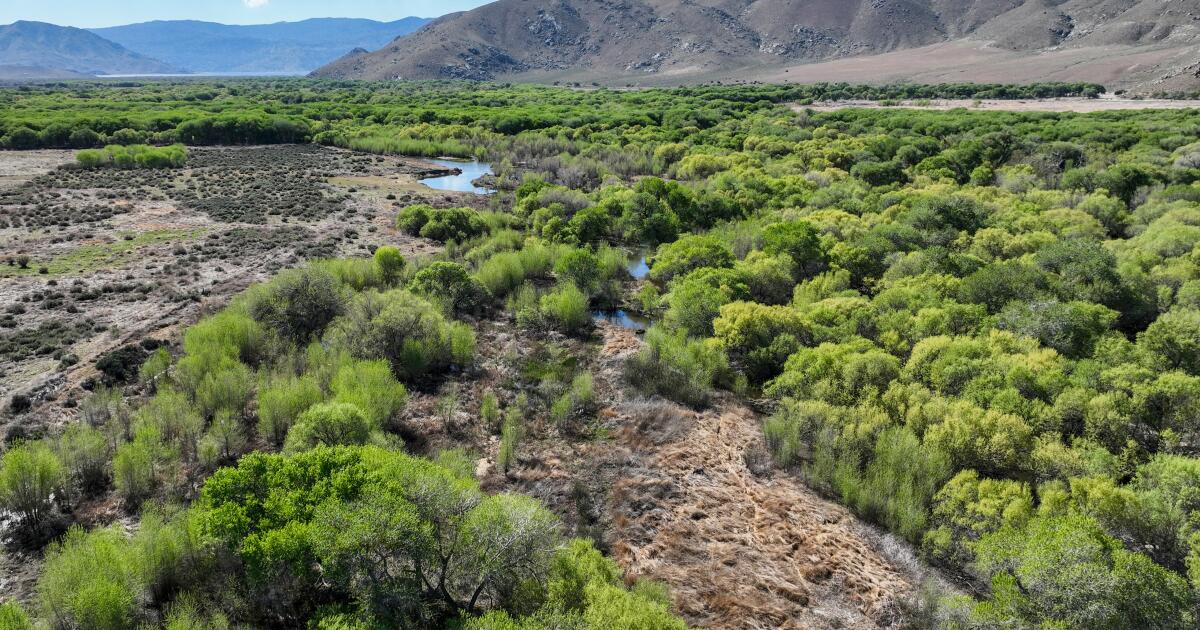
California is recognized as one of the world’s hotspots of biodiversity, with more species of plants and animals than any other state. And a significant number of the state’s species, from frogs to birds, live in habitats that depend on groundwater.
These rich ecosystems — including spring-fed streams, wetlands, riparian forests and oak woodlands — are vulnerable to declines in groundwater levels. In areas where unchecked pumping from wells severely depletes aquifers, once-thriving wetlands and forests can dry up and die.
Spotting threats to vulnerable natural areas has become a mission for Melissa Rohde, a hydrologist who has spent years analyzing satellite data and water levels in wells to come up with strategies for preventing ecosystems from being left high and dry.
“Nature has been getting the short end of the stick. It basically gets whatever is left behind, which oftentimes is not enough,” Rohde said. “How do we ensure that these ecosystems are protected?”
More than 300 species of birds have been seen at Kern River Preserve.
(Robert Gauthier / Los Angeles Times)
California is the only state with a groundwater law that includes provisions intended to protect groundwater-dependent ecosystems. But the law, adopted in 2014, gives considerable leeway to local agencies in developing water management plans that prevent “significant and unreasonable adverse impacts.”
When Rohde and other scientists examined the local plans for parts of the state that fall under regulation, they found only about 9% of groundwater-dependent ecosystems are adequately protected, while the remaining 91% are vulnerable.
When they looked at the entire state, they determined only 1% of the ecosystems are sufficiently protected under measures adopted to date.

Aggressive and impactful reporting on climate change, the environment, health and science.
Rohde has been focusing on finding ways to change that, in California and around the world.
Often working at home, she has pored over satellite data to spot decreases in vegetation greenness during drought, a telltale sign of die-off caused by declining aquifer levels. And she has analyzed how different types of trees, including willows, cottonwoods and oaks, fare when water levels fall depending on the depth of their roots.
Rohde and other researchers recently published a study outlining how California can set targets for maintaining groundwater levels — based on a formula including the type of vegetation, local water data and satellite imagery — to ensure the plants that anchor each ecosystem will be able to reach water and survive during dry times.
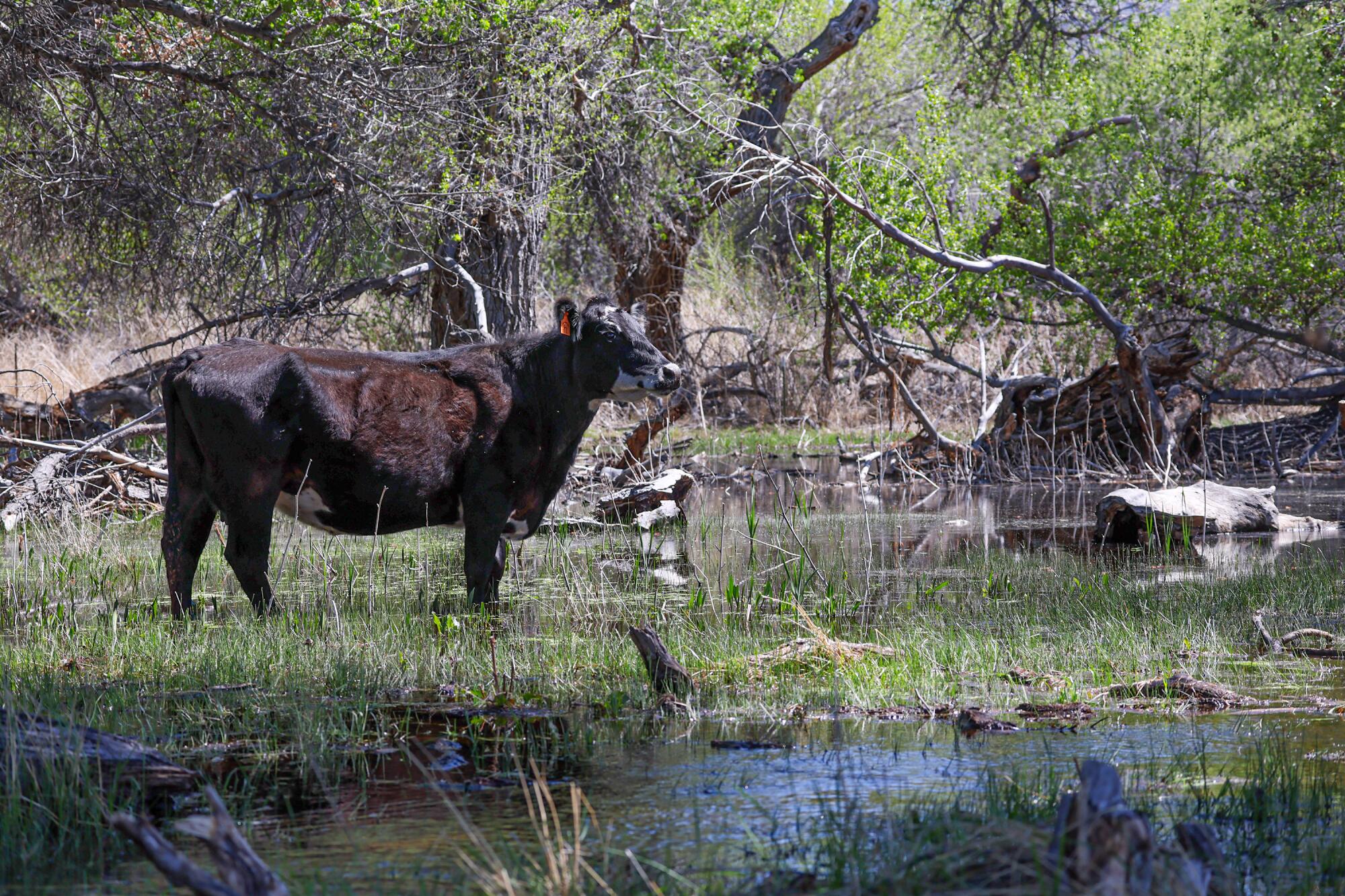
Cattle graze at the Kern River Preserve.
(Robert Gauthier / Los Angeles Times)
“If we don’t have groundwater levels that are able to support these diverse native vegetation ecosystems, then basically we run the risk of losing that important habitat for a lot of our threatened and endangered species,” Rohde said. “When you play around with keeping groundwater levels too deep to support the habitat, then you could lose species, and then that’s irreversible. The consequences can be severe.”
In California’s Mediterranean climate, trees, shrubs and the species they support are naturally adapted to drought. But excessive pumping from wells can push habitats beyond ecological limits by depleting the sources that sustain them.
With humanity’s heating of the planet intensifying droughts, the strains affecting these ecosystems continue to grow.
Already, California has lost the vast majority of its original wetlands to development, water diversions and agriculture. To avoid losing what remains, Rohde said, the state needs “a precautionary and preventative approach that can ensure that these ecosystems can withstand the intensification of droughts in climate change.”
During a recent visit to Kern County, Rohde and several conservation specialists walked in the shade through a lush forest of cottonwood trees near the south fork of the Kern River, visiting a nature preserve she had previously seen only in satellite images.
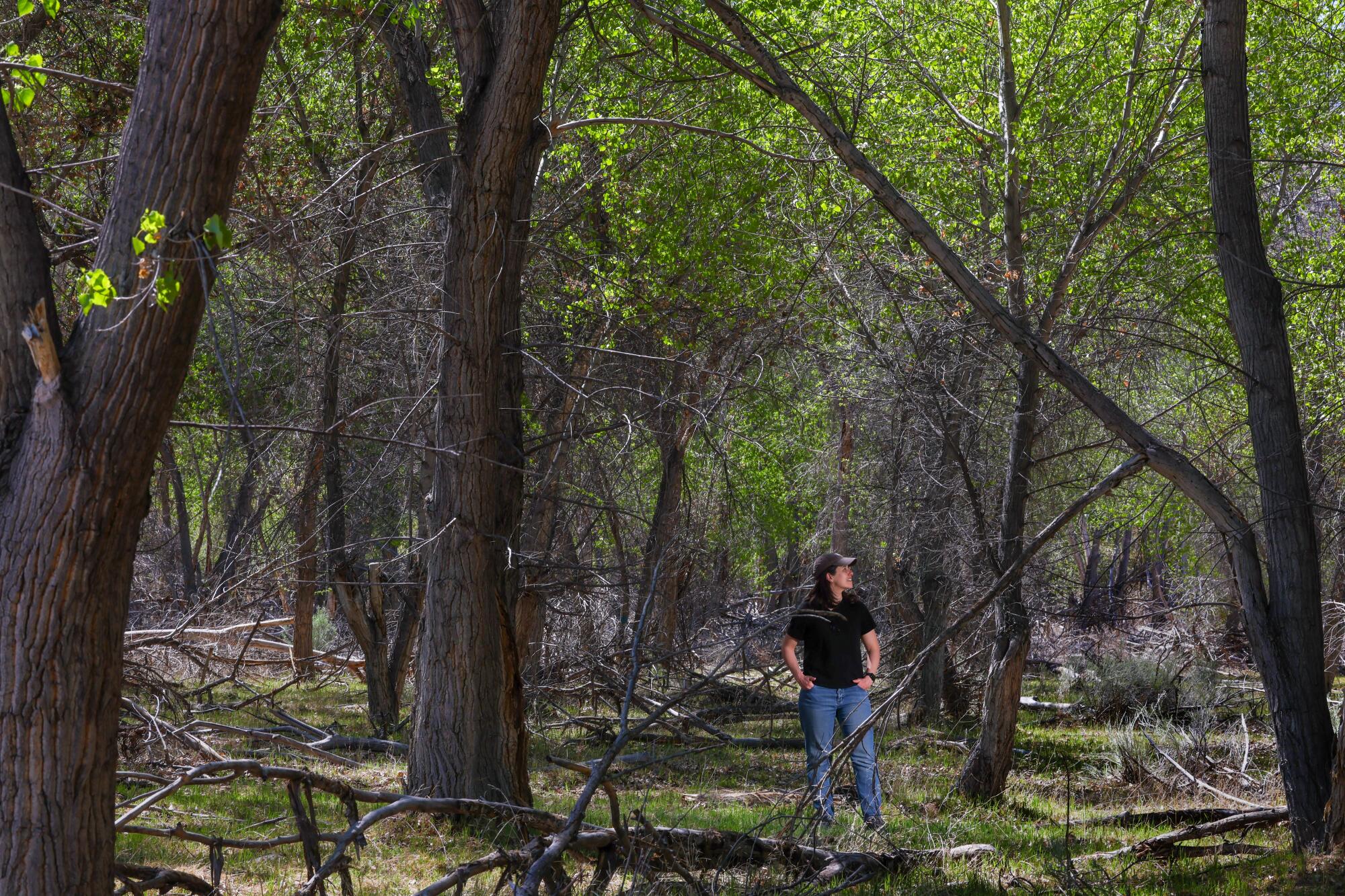
Scientist Melissa Rohde visits a riparian forest at the Kern River Preserve.
(Robert Gauthier / Los Angeles Times)
At the edge of a clearing, she came upon the bare, sunbleached skeletons of dead trees.
She said satellite data had revealed that parts of the forest died along this part of the Kern River during the drought between 2012 and 2016.
“That’s because the groundwater levels rapidly declined,” Rohde said.
After that die-off, she said, groundwater levels rebounded in the area, and the native vegetation has been growing back.
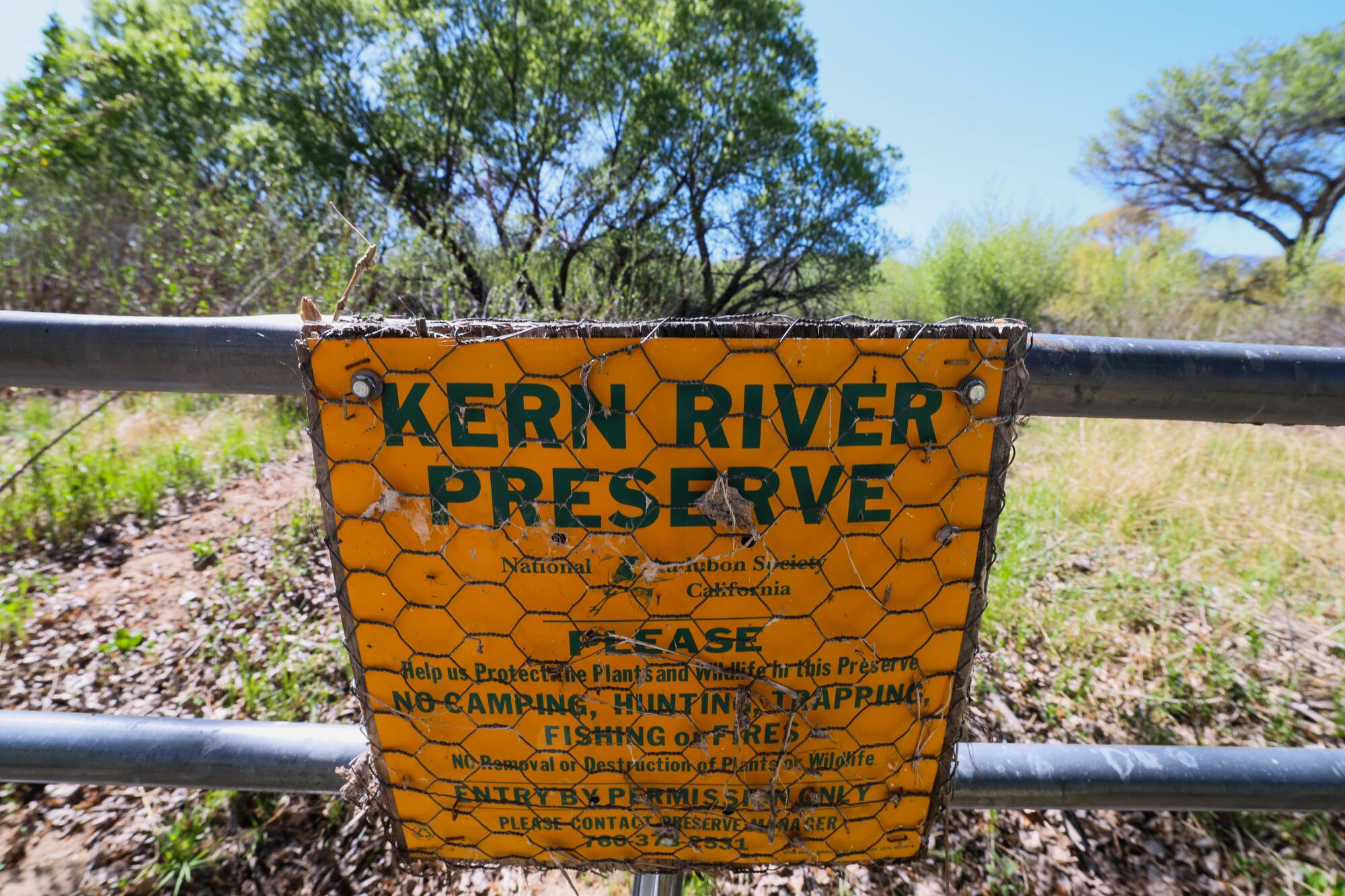
The Kern River Preserve protects the riparian ecosystem along the south fork of the Kern River.
(Robert Gauthier / Los Angeles Times)
It helps that this forest is protected as part of the Kern River Preserve, which is managed by the National Audubon Society, and that some nearby farmlands have been retired and converted to conservation lands over the years.
The preserve’s managers, working with the organization Ducks Unlimited, have also restored an expanded wetland by diverting water from the river and flooding a section of pastureland where cattle used to graze.
The wetland attracts birds, such as coots and tricolored blackbirds, and also recharges the aquifer that the roots of cottonwoods and willows tap into.
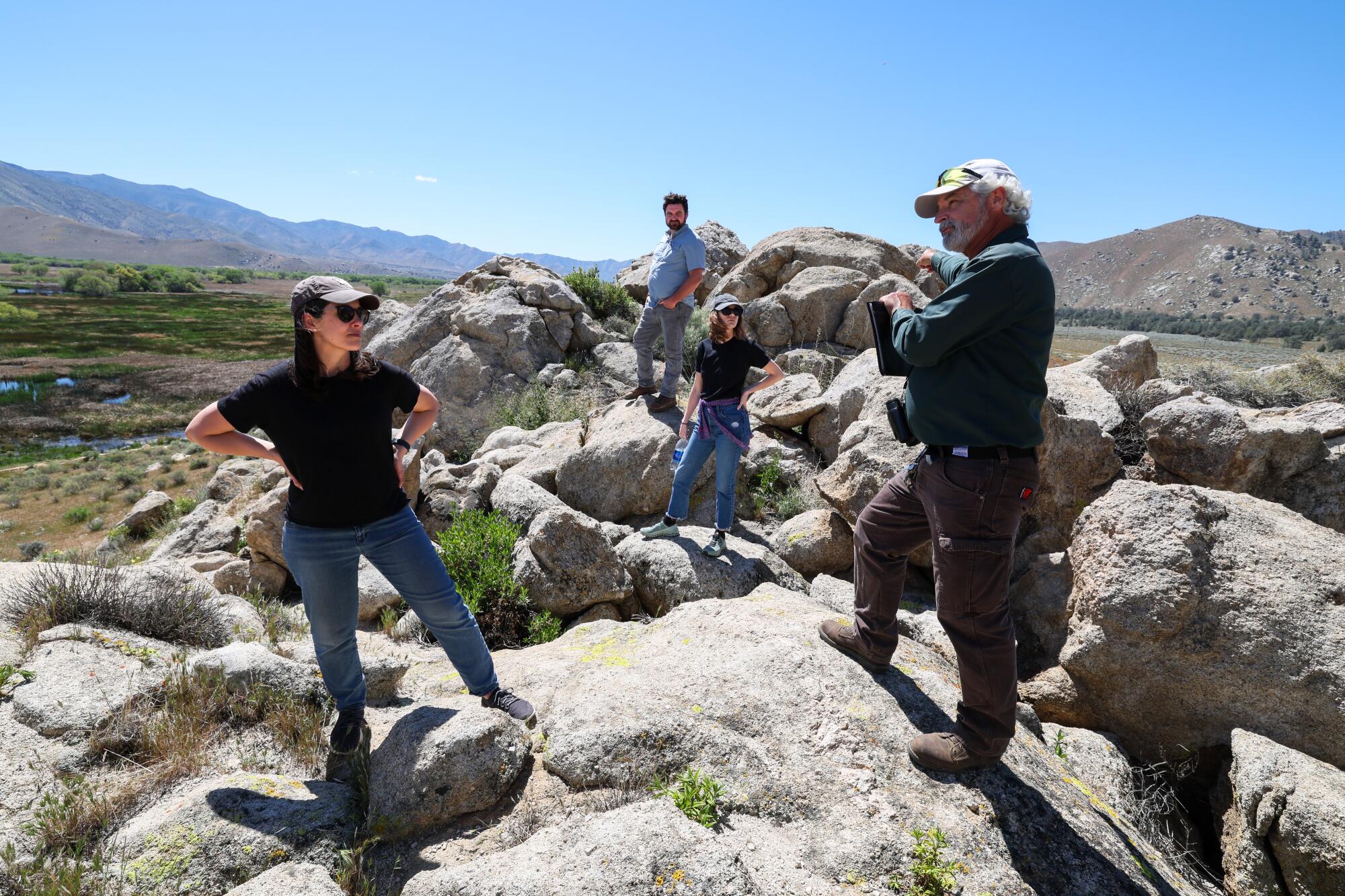
Scientist Melissa Rohde, left, and conservation specialists from Ducks Unlimited and the Audubon Society, including Reed Tollefson, right, stand on rocks overlooking a wetland at the Kern River Preserve.
(Robert Gauthier / Los Angeles Times)
The 3,300-acre preserve has expanded as adjacent alfalfa fields have been purchased and agricultural wells have been shut down, said Reed Tollefson, the preserve’s manager. These efforts have helped protect a refuge for birds including willow flycatchers and yellow-billed cuckoos.
As he pointed to several dead trees poking from the living cottonwoods, he said protecting the forest from groundwater pumping and climate change will require additional effort.
“I think it’s tenuous,” he said. “We’ve got more work to do to try and really sustain this.”
The dead trees that have appeared here and elsewhere in California over the past decade represent the sort of die-off that water managers need to focus on preventing, Rohde said.
“It has to be an intentional practice of setting thresholds, monitoring, using satellite data or other scalable means to measure the impacts, in order to make sure that we are not allowing this to happen on a wider scale,” she said. “From a biodiversity perspective, it’s absolutely critical.”
Rohde said she felt hopeful seeing the forest rebounding and much greener than it was several years ago, with many young trees coming up.
Some other parts of California haven’t fared nearly as well.
One rainy day last month, Rohde visited an area along the Santa Clara River in Ventura County where several hundred acres of willows and cottonwoods dried up and died during the drought in the mid-2010s.
When groundwater pumping by farms and communities caused aquifer levels to fall, many trees died along the river near the city of Fillmore.
“We saw this catastrophic drop in groundwater at this site,” Rohde said.
She visited the area with a research colleague and two managers from The Nature Conservancy. They stood on a gravel road next to a lemon grove, checking on what remained of the forest.
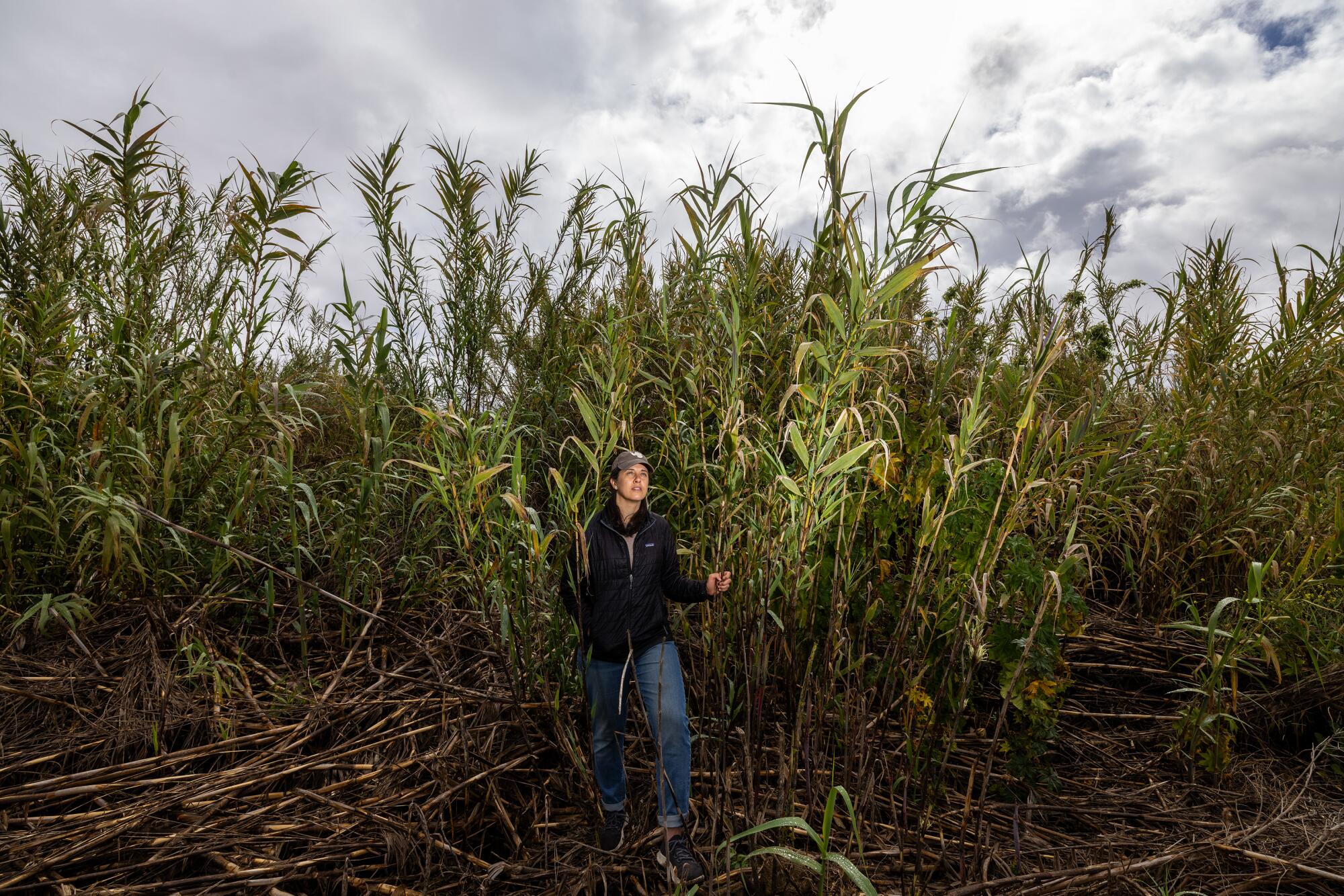
Scientist Melissa Rohde stands in a thicket of arundo, an invasive reed that has proliferated along parts of the Santa Clara River in Ventura County. There are ongoing efforts to remove the nonnative reeds in the area.
(Brian van der Brug / Los Angeles Times)
Where native trees died, an explosion of invasive reeds has taken over. The nonnative reeds, called arundo, have grown into thickets more than 20 feet tall. And unlike willows, Rohde said, arundo offers little value as habitat for birds.
“When we had that massive die-off, and the groundwater levels remained deep, there was no way for the native vegetation to regenerate,” she said. “But arundo is extremely efficient at extracting soil moisture. And so it was able to outcompete the native vegetation.”
She said efforts to prevent this sort of habitat degradation should be prioritized.
When managers of local agencies set goals for maintaining groundwater levels, she said, they can tailor targets to the type of vegetation — whether there are cottonwood trees, with roots averaging about 9 feet long, or oaks, with roots that average nearly 30 feet but can grow much deeper.
Her colleague Michael Bliss Singer said when native trees are ravaged by multiple years of low water levels, they will start losing leaves and then dropping branches.
In one study, Singer and others documented a “brown wave” of trees drying along the Santa Clara River between 2012 and 2016 — a loss they saw in satellite images.
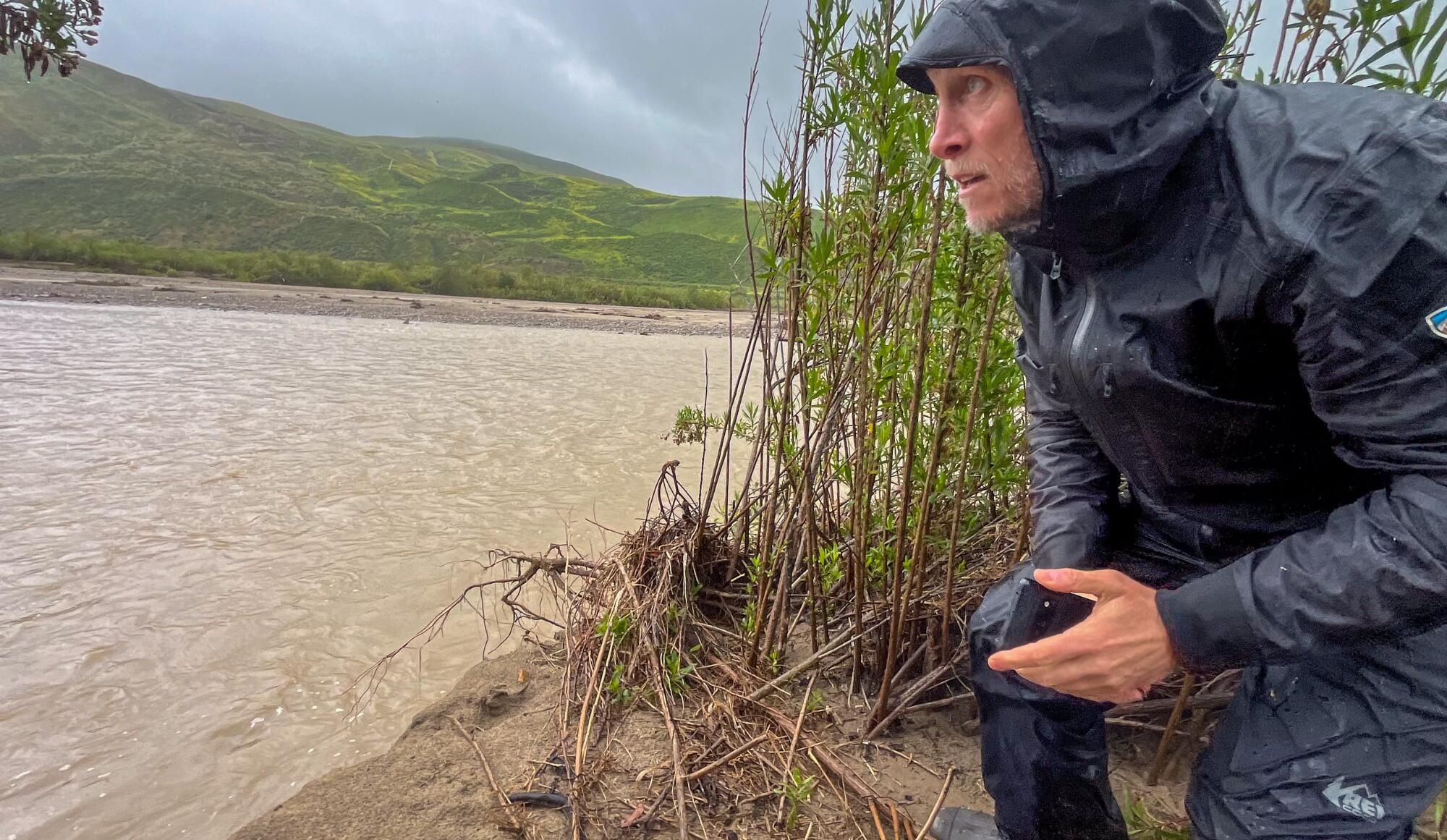
Scientist Michael Bliss Singer looks out over the Santa Clara River in Ventura County.
(Brian van der Brug / Los Angeles Times)
“It’s completely transformed the ecosystem here,” said Singer, a professor at Cardiff University in Wales who is also a researcher at UC Santa Barbara.
When plants die off like this and don’t recover, it’s a symptom of an ecosystem in decline. To prevent more of these losses in an era when climate change is driving more severe droughts, Singer said, it’s crucial to “come up with creative solutions for the worst-case scenario.”
Rohde has found in her research, however, that most local groundwater plans in California haven’t adequately accounted for climate projections.
Previously, Rohde did other types of climate research, including a stint in Antarctica in 2010, where she was part of a drilling team collecting ice cores. From that experience, Rohde said she realized that “I didn’t want to spend my career convincing people that climate change was an issue; I wanted to do something about it.”
She wore a faded cap with an Antarctica map, a memento of that trip. Rohde said her recent work is motivated by concerns about the climate crisis and biodiversity, as well as a conviction that proactive steps to protect ecosystems can make a difference.
“I have two young kids. I really want to make sure that I’m doing the best thing that I can to ensure a sustainable future for them, where they can access nature,” Rohde said.

E.J. Remson, a senior project director for The Nature Conservancy, surveys a wetland along the Santa Clara River in Ventura County.
(Brian van der Brug / Los Angeles Times)
“Often groundwater is out of sight, out of mind,” she said. “We don’t measure it, we don’t understand it and we misuse it. And we need to make sure that we are managing groundwater so that it is supporting us, and making sure that we have a sustainable future.”
Rohde now works as an independent scientist. Previously, as a researcher for The Nature Conservancy, she helped write an atlas of threatened and endangered species that rely on groundwater.
California’s groundwater-dependent ecosystems lie not only along streams, but also in habitats such as mountain meadows, coastal redwood forests and mesquite bushes among desert sand dunes. The species they support range from tiger salamanders to desert pupfish, and from songbirds to mammals such as ground squirrels and bighorn sheep.
“The risks are high when species are on the verge of extinction,” Rohde said.
Rohde and other scientists have found that ecosystems sustained by groundwater are under threat worldwide. Some of the few regions that have measures intended to protect them, she said, include Australia, the European Union and California.
Still, even with California’s groundwater regulations and endangered species laws, Rohde said, “we continue to miss the mark in actually protecting them.”
Rohde said state officials should give local water agencies clear direction to ensure they’re using science-based methods to safeguard ecosystems in their state-mandated plans. She said agencies can now use the approaches scientists have outlined to map strongholds of biodiversity and set targets for maintaining aquifer levels.
“It’s very attainable,” she said. “Now, it’s just basically up to political will, or enforcement by the Department of Water Resources, to ensure that that happens.”
Walking in the rain at the Santa Clara River Preserve, Rohde followed her former Nature Conservancy colleagues Peter Dixon and E.J. Remson on a trail through a stand of healthy trees.
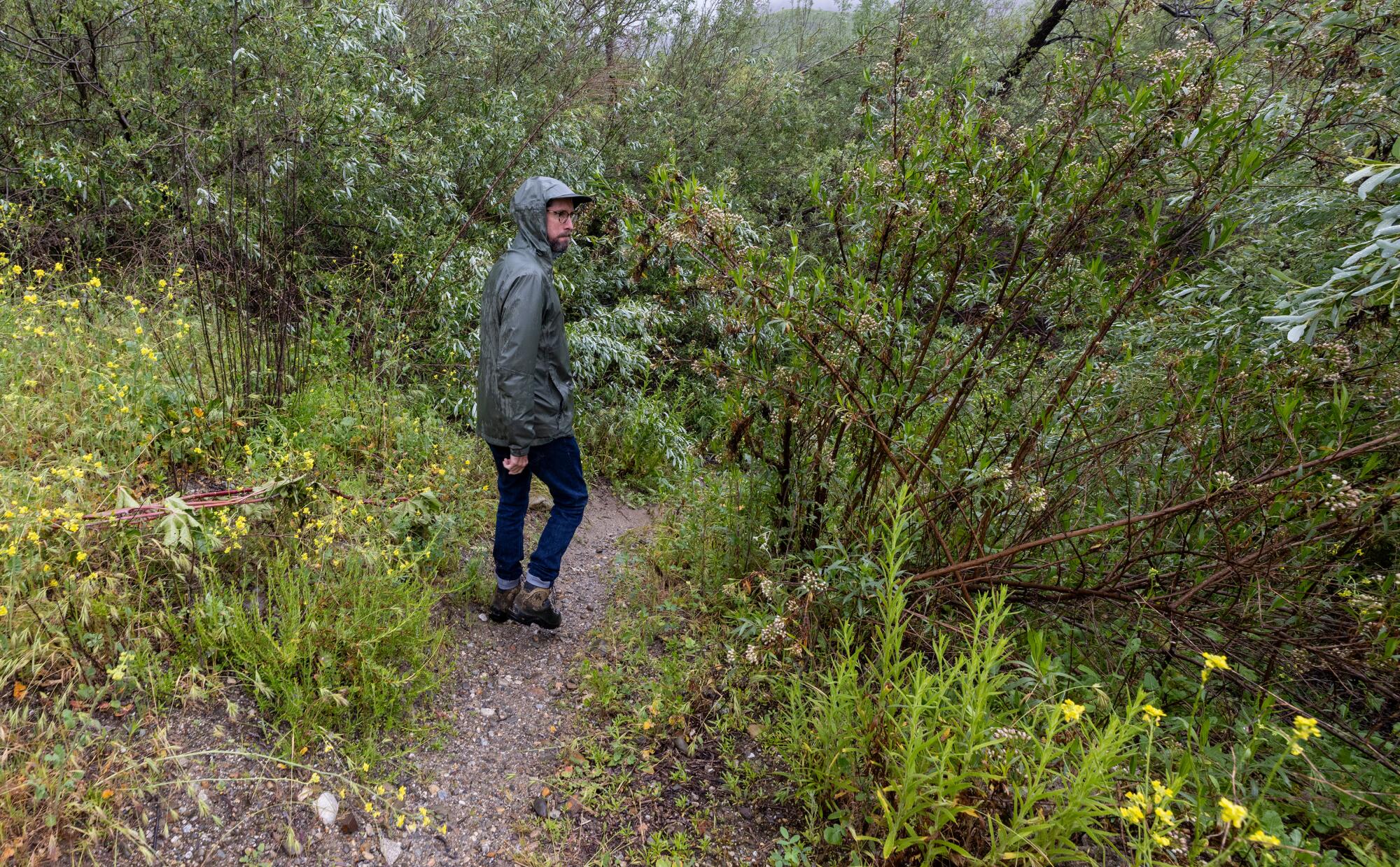
Peter Dixon, a project manager with The Nature Conservancy, walks on a trail through the riparian forest at the Santa Clara River Preserve.
(Brian van der Brug / Los Angeles Times)
They stood on the banks of the fast-flowing river, watching the muddy water churn past.
In the summer and fall, this part of the river usually dwindles to a trickle.
And during the next drought, when the river dries up, the forest will depend on the same groundwater that nearby communities and farms also use.
If the water needs of this and other ecosystems aren’t prioritized, Rohde said, vital habitats will suffer.
“We need to be deliberate about the planning, and ensuring that they get their fair share,” she said. “Their existence is potentially imperiled if we don’t act.”

Science
Q&A: Learn how Olympians keep their cool from Team USA's chief sports psychologist

Your morning jog or weekly basketball game may not take place on an Olympic stage, but you can use Team USA’s techniques to get the most out of your exercise routine.
It’s not all about strength and speed. Mental fitness can be just as important as physical fitness.
That’s why the U.S. Olympic & Paralympic Committee created a psychological services squad to support the mental health and mental performance of athletes representing the Stars and Stripes.
“I think happy, healthy athletes are going to perform at their best, so that’s what we’re striving for,” said Jessica Bartley, senior director of the 15-member unit.
Bartley studied sports psychology and mental health after an injury ended her soccer career. She joined the USOPC in 2020 and is now in Paris with Team USA’s 592 competitors, who range in age from 16 to 59.
Bartley spoke with The Times about how her crew keeps Olympic athletes in top psychological shape, and what the rest of us can learn from them. Her comments have been edited for length and clarity.
Why is exercise good for mental health?
It gets you moving. It gets the endorphins going. And there’s often a lot of social aspects that are really helpful.
There are a number of sports that stretch your brain in ways that can be really, really valuable. You’re thinking about hand-eye coordination, or you’re thinking about strategy. It can improve memory, concentration, even critical thinking.
What’s the best way to get in the zone when it’s time to compete?
When I work with athletes, I like to understand what their zone is. If a 0 or a 1 is you’re totally chilled out and a 10 is you’re jumping around, where do you need to be? What’s your number?
People will say, “I’m at a 10 and I need to be at an 8 or a 7.” So we’ll talk about ways of bringing it down, whether it’s taking a deep breath, listening to relaxing music, or talking to your coach. Or there’s times when people say they need to be more amped up. That’s when you see somebody hitting their chest, or jumping up and down.
If you make a mistake in the middle of a competition, how do you move on instead of dwelling on it?
I often teach athletes a reset routine. I played goalie, so I had a lot of time to think after getting scored on. I would undo my goalie gloves and put them back on, which to me was a reset. I would also wear an extra hairband on my wrist, and when I would snap it, that meant I needed to get out of my head.
It’s not just a physical reset — it helps with a mental reset. If you do the same thing every single time, it goes through the same neural pathway to where it’s going to reset the brain. That can be really impactful.
Do Olympic athletes have to deal with burnout?
Oh, yeah. Everybody has a day where they don’t want to do whatever it is. That’s when you have to ask, “What’s in my best interests? Do I need a recovery day, or do I really need to get in the pool, or get in the gym?”
Sometimes you really do need what we like to refer to as a mental health day.
How can you psych yourself up for a workout when you just aren’t feeling it?
It’s really helpful to think about why you’re doing this and why you’re pushing yourself. Do you have goals related to an activity or sport? Is there something tied to values around hard work or discipline, loyalty or dependability?
When you don’t want to get in the gym, when you don’t want to go for a run, think about something bigger. Tie it back to values.
Is sleep important for maintaining mental health?
Yes! We started doing mental health screens with athletes before the Tokyo Games. We asked about depression, anxiety, disordered eating and body image, drugs and alcohol, and sleep. Sleep was actually our No. 1 issue. It’s been a huge initiative for us.
How much sleep should we be getting?
It’s different for everyone, but generally we know seven to nine hours of sleep is good. Sometimes some of these athletes need 10 hours.
I highly recommend as much sleep as you need. If you didn’t get enough sleep, napping can be really valuable.
Is napping just for Olympic athletes or is it good for everybody?
Everybody! Naps are amazing.
What if there’s no time for a nap?
There are different ways of recharging. Naps could be one of them, but maybe you just need to get off your feet for 20 minutes. Maybe you need to do a meditation or mindfulness exercise and just close your eyes for five minutes.
How do you minimize the effects of jet lag?
We try to shift one hour per day. That’s the standard way of doing it. If you can, it’s super helpful. But it’s not always possible.
The thing we tell athletes is that our bodies are incredible, and you will even things out if you can get back on schedule. One or two nights of crummy sleep is not going to impact your overall performance.
What advice do you give athletes who have trouble falling asleep the night before a competition?
You don’t want to change much right before a competition, so I usually direct athletes to do what they would normally do.
Do you need to unwind by reading a book? Do you need to talk on the phone with somebody and get your mind off things? Can you put your mind in a really restful place and think about things that are really relaxing?
Are there any mindfulness or meditation exercises that you find helpful?
There are some athletes who benefit greatly from an hourlong meditation. I love something quick, something to reset my brain, maybe close my eyes for a minute.
If I’m feeling like I need to take a moment, I love mindful eating. You savor a bite and go, “Oh, my gosh, I have not been fully engaged with my senses today.” Or you could take a mindful walk and take in the sights, the smells, all of the things that are around you.
What do you eat when you need a quick nutrition boost?
Cashews. I tend to carry those with me. They’ve got enough energy to make sure I keep going, physically.
I’ve always got gummy bears on me too. There’s no nutritional value but they keep me going mentally. I’m a big proponent of both.
Is it OK to be superstitious in sports?
It depends how flexible you are. Maybe you put on your socks or shoes a certain way, or listen to certain music. Routines are really soothing. They set your brain up for success in a particular performance. It can be really, really helpful.
But I’ve also seen an athlete forget their lucky underwear or their lucky socks, and they’re all out of sorts. So your routine has to be flexible enough that you’re not going to completely fall apart if you don’t do it exactly.
Are Olympians made of stronger psychological stuff than the rest of us?
Not necessarily. There are some who don’t get feathers ruffled and have a high tolerance for the fanfare. There’s also a lot of regular human beings who just happen to be fantastic at a particular activity.
Science
‘Ready, Steady, Slow’: Championship Snail Racing at 0.006 M.P.H.

Earlier this month, the rural village of Congham, England, played host to a less likely group of athletes: dozens of garden snails. They had gathered to compete in the World Snail Racing Championships, where the world record time for completing the 13.5 inch course stands at 2 minutes flat. At that speed — roughly 0.006 miles per hour — it would take the snails more than six days to travel a mile.
Science
Caring for condor triplets! Record 17 chicks thrive at L.A. Zoo under surrogacy method
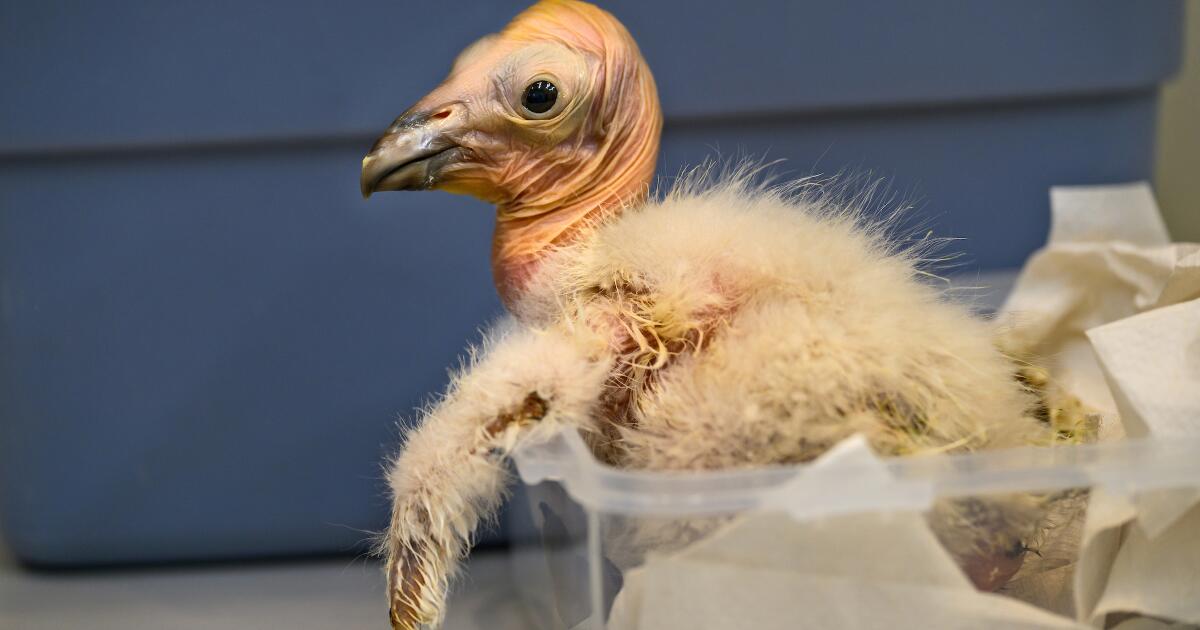
A new method of rearing California condors at the Los Angeles Zoo has resulted in a record-breaking 17 chicks hatched this year, the zoo announced Wednesday.
All of the newborn birds will eventually be considered for release into the wild under the U.S. Fish and Wildlife Service’s California Condor Recovery Program, a zoo spokesperson said.
“What we are seeing now are the benefits of new breeding and rearing techniques developed and implemented by our team,” zoo bird curator Rose Legato said in a statement. “The result is more condor chicks in the program and ultimately more condors in the wild.”
Breeding pairs of California condors live at the zoo in structures the staff “affectionately calls condor-miniums,” spokesperson Carl Myers said. When a female produces a fertilized egg, the egg is moved to an incubator. As its hatching approaches, the egg is placed with a surrogate parent capable of rearing the chick.
California condor eggs are cared for at L.A. Zoo. The animal is critically endangered.
(Jamie Pham / L.A. Zoo)
This bumper year of condor babies is the result of a modification to a rearing technique pioneered at the L.A. Zoo.
Previously, when the zoo found itself with more fertilized eggs than surrogate adults available, staff raised the young birds by hand. But condors raised by human caretakers have a lower chance of survival in the wild (hence the condor puppets that zookeepers used in the 1980s to prevent young birds from imprinting on human caregivers).
In 2017, the L.A. Zoo experimented with giving an adult bird named Anyapa two eggs instead of one. The gamble was a success. Both birds were successfully released into the wild.
Faced with a large number of eggs this year, “the keepers thought, ‘Let’s try three,’” Myers said. “And it worked.”
The zoo’s condor mentors this season ultimately were able to rear three single chicks, eight chicks in double broods and six chicks in triple broods. The previous record number of 15 chicks was set in 1997.
Condor experts applauded the new strategy.
“Condors are social animals and we are learning more every year about their social dynamics. So I’m not surprised that these chick-rearing techniques are paying off,” said Jonathan C. Hall, a wildlife ecologist at Eastern Michigan University. “I would expect chicks raised this way to do well in the wild.”
The largest land bird in North America with an impressive wingspan up to 9½ feet, the California condor could once be found across the continent. Its numbers began to decline in the 19th century as human settlers with modern weapons moved into the birds’ territory. The scavenger species was both hunted by humans and inadvertently poisoned by lead bullet fragments embedded in carcasses it ate. The federal government listed the birds as an endangered species in 1967.
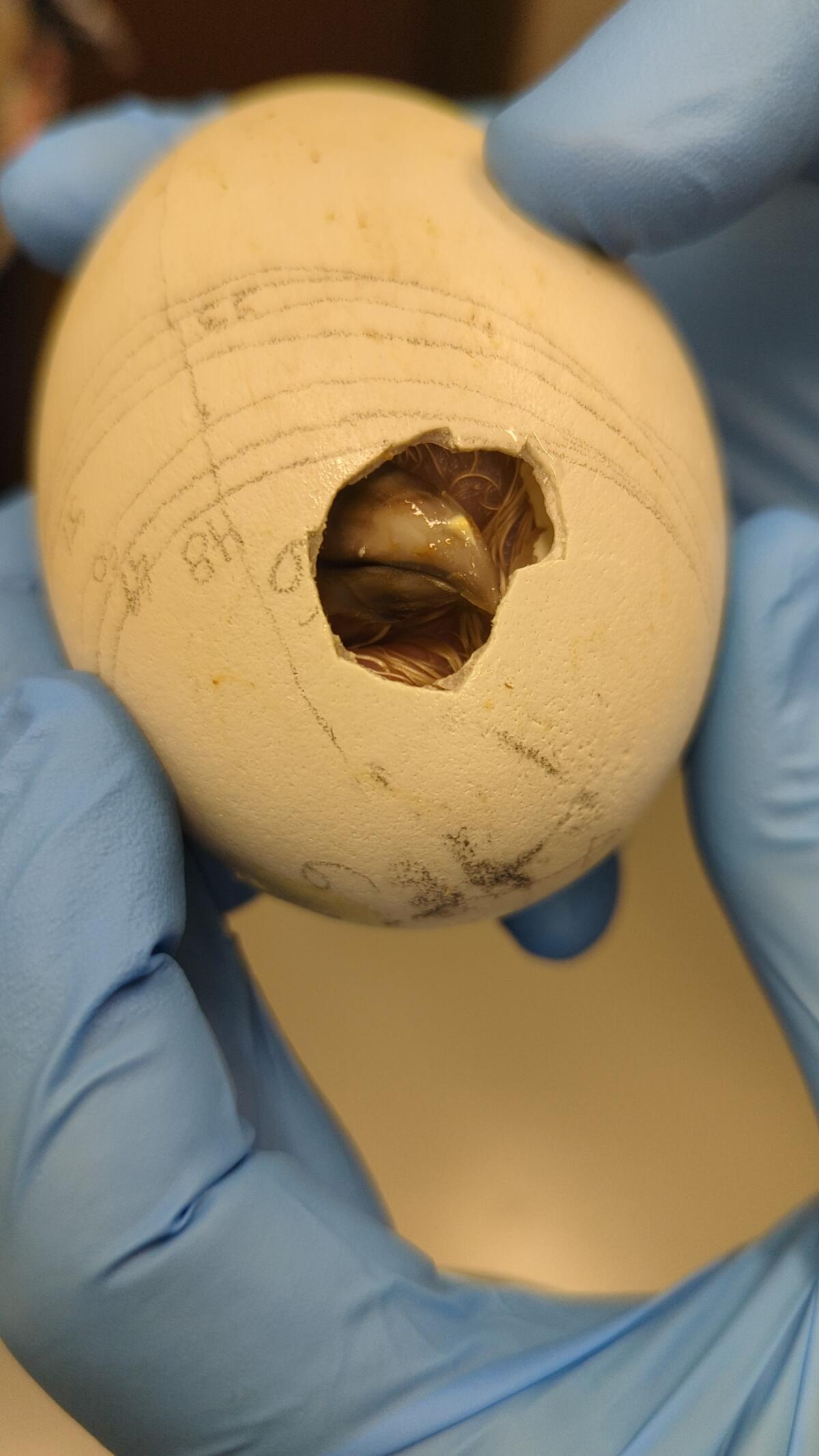
A condor, one of a record-breaking 17 at the zoo, makes its way out of its shell.
(Jamie Pham / L.A. Zoo)
When the California Condor Recovery Program began four decades ago, there were only 22 California condors left on Earth. As of December, there were 561 living individuals, with 344 of those in the wild. Despite the program’s success in raising the population’s numbers, the species remains critically endangered.
In addition to the ongoing threat of lead poisoning, the large birds are also at risk from other toxins. One 2022 study found more than 40 DDT-related compounds in the blood of wild California condors — chemicals that had made their way from contaminated marine life to the top of the food chain.
“Despite our success in returning condors to the wild, free-flying condors continue to face many obstacles with lead poisoning being the No. 1 cause of mortality,” said Joanna Gilkeson, spokesperson for Fish and Wildlife’s Pacific Southwest Region. “Innovative strategies, like those the L.A. Zoo is implementing, help us to produce more healthy chicks and continue releasing condors into the wild.”
The chicks will remain in the zoo’s care for the next year and a half before they are evaluated for potential release to the wild. Thus far, the zoo has contributed 250 condor chicks to Fish and Wildlife’s program, some of which the agency has redeployed to other zoos as part of its conservation efforts.
In a paper published earlier this year, a team of researchers found that birds born in captivity have slightly lower survival rates for their first year or two but then have equally successful outcomes to wild-hatched birds.
“Because condors reproduce slowly, releases of captive-bred birds are essential to the recovery of the species, especially in light of ongoing losses due to lead-related mortality,” said Victoria Bakker, a quantitative ecologist at Montana State University and lead author of the paper. “The team at the L.A. Zoo should be recognized for their innovative and important contributions to condor recovery.”
-

 World1 week ago
World1 week agoOne dead after car crashes into restaurant in Paris
-

 Midwest1 week ago
Midwest1 week agoMichigan rep posts video response to Stephen Colbert's joke about his RNC speech: 'Touché'
-

 News1 week ago
News1 week agoVideo: Young Republicans on Why Their Party Isn’t Reaching Gen Z (And What They Can Do About It)
-

 Movie Reviews1 week ago
Movie Reviews1 week agoMovie Review: A new generation drives into the storm in rousing ‘Twisters’
-

 News1 week ago
News1 week agoIn Milwaukee, Black Voters Struggle to Find a Home With Either Party
-

 Politics1 week ago
Politics1 week agoFox News Politics: The Call is Coming from Inside the House
-

 News1 week ago
News1 week agoVideo: J.D. Vance Accepts Vice-Presidential Nomination
-

 World1 week ago
World1 week agoTrump to take RNC stage for first speech since assassination attempt
















